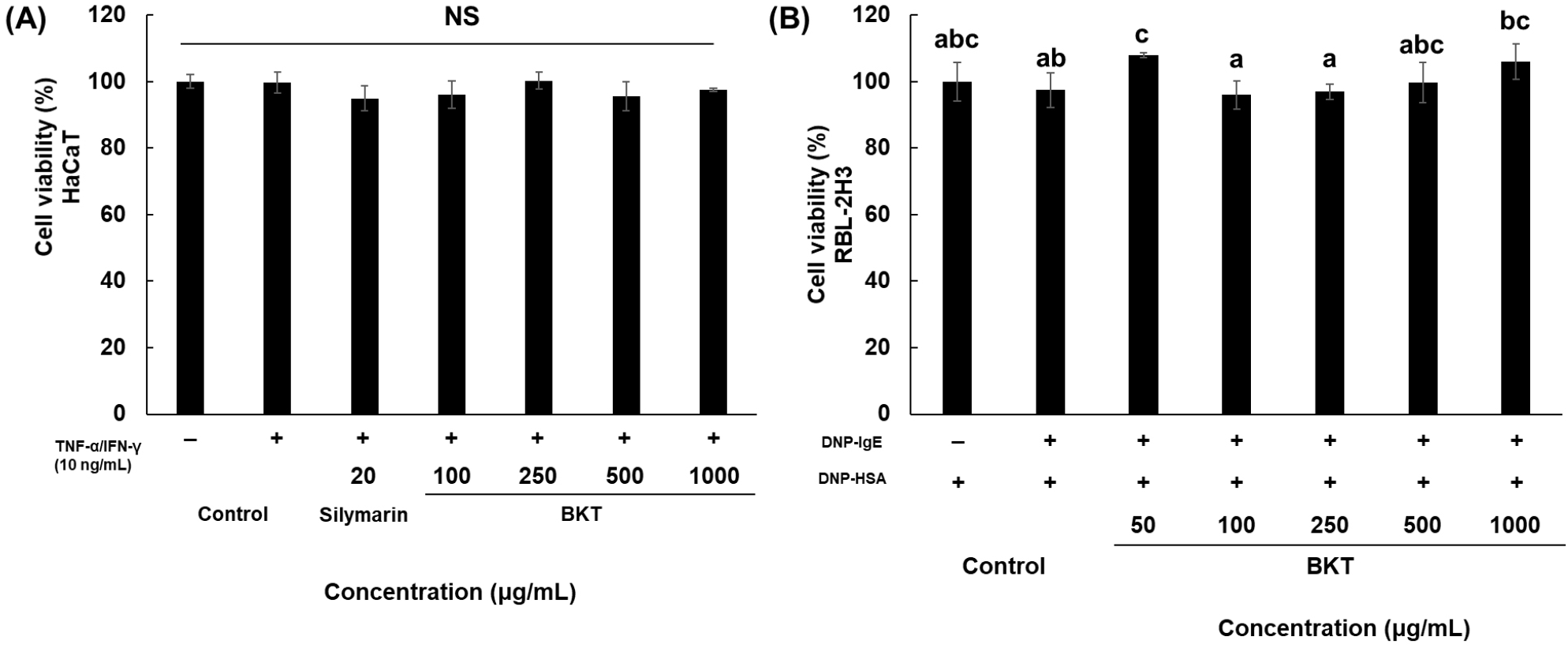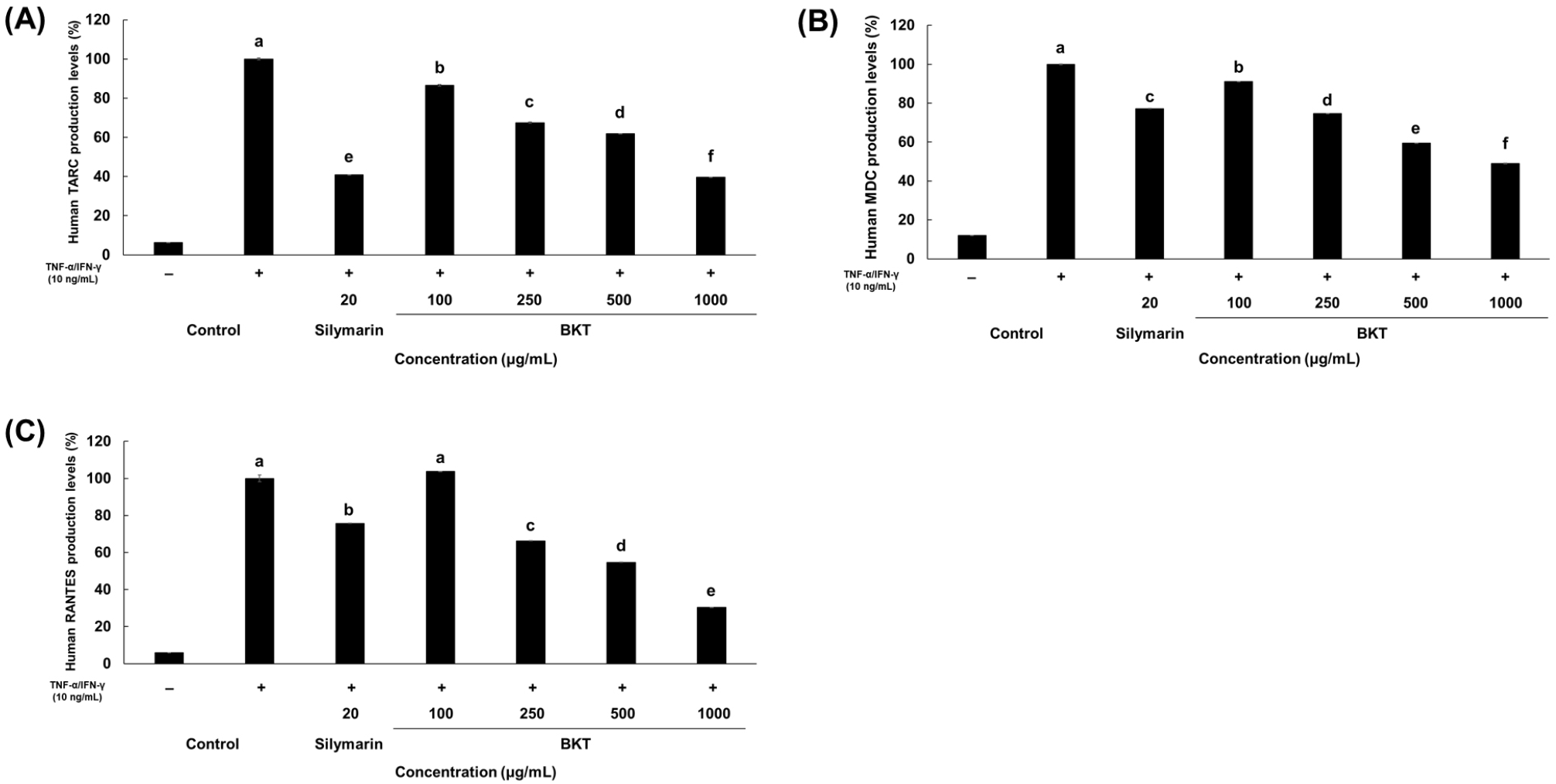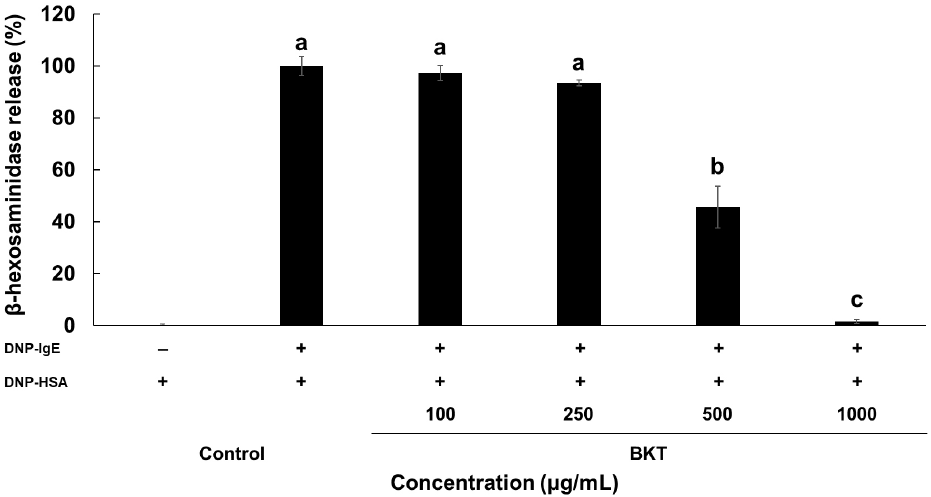1. 서론
현대 사회에서 피부염증과 알러지 반응은 인간 건강과 삶의 질에 영향을 미치는 심각한 문제로 간주되며, 이러한 문제는 음식, 환경 오염, 알레르겐 및 박테리아 노출, 유전적 요인 등 다양한 원인으로 인해 증가하고 있는 실정이다(Lee 등, 2014). 이러한 피부염증과 알러지 반응은 피부각질세포 및 면역세포의 활성화와 상호작용에 의해 유발되며, 관련된 세포 및 분자의 활동 조절은 염증과 알러지의 진행을 조절하는 데 중요한 역할을 한다(Chung 등, 2011; Kim 등, 2023). 피부 내 각질형성세포인 keratinocyte는 표피층에 존재하는 주요 구성 세포로, 세포 분화를 통해 피부 장벽을 형성하는 역할을 한다(Oh와 Jang, 2015). 이러한 피부각질세포가 수많은 항원과 접촉하고 스트레스 환경에 노출되면 다양한 케모카인(chemokine)과 사이토카인(cytokine) 등 염증 매개 인자를 생성한다(Jo, 2022). 장기적인 피부 손상으로 케모카인과 사이토카인이 지속적으로 생성되면 피부염증 및 건조를 유발하여 피부염, 건선, 아토피 피부염(atopic dermatis, AD) 등의 피부질환이 유도된다(Hudson, 2006). 알러지에 의해 발생하는 피부염증 질환 중 하나인 급성 AD는 T-helper 2-type 세포(Th2)의 피부 병변으로의 침윤 및 Th2 관련 사이토카인인 인터루킨(Interleukin, IL)-4, IL-5 및 IL-13의 분비 증가로 정의된다(Lee 등, 2010). 대부분의 AD 환자는 Th1 세포 수가 감소하고 Th2 반응에 대응할 수 있는 인터페론(IFN-)과 같은 Th1 사이토카인의 농도가 낮으며(Lee 등, 2010), 초기 면역글로불린 E (immunoglobulin E, IgE) 생산 및 이후 알레르겐/IgE 반응과 관련이 있을 가능성이 높은 것으로 알려져 있다(Bergmann 등, 1998). Th2 세포는 Thymus and activation-regulated chemokine (TARC/CCL17)과 macrophage-derived chemokine (MDC/CCL22)에 의해 유도되며, TARC 및 MDC는 AD와 같은 일부 피부 질환의 발병에 중요한 역할을 하는 것으로 사료된다. 다수의 연구에서, AD 환자의 혈청 중 TARC와 MDC 케모카인 수준이 현저하게 상승하며, 이러한 케모카인 수준의 상승과 환자의 질병 심각도 간에 상관관계가 있는 것으로 확인되었다(Furukawa 등, 2004; Hashimoto 등, 2006). 더불어, AD와 관련이 있는 또 다른 케모카인인 Regulated on activation, normal T cell expressed and secreted (RANTES/CCL5)도 AD와 관련이 있는 것으로 알려져 있다(Homey와 Zlotnik, 1999). RANTES/CCL5는 AD 환자의 피부에서 높은 농도로 검출되었으며, 이 케모카인의 주요 공급원은 진피 섬유아세포로 확인되었다(Schroder 등, 1996).
알러지 반응은 항원의 결합에 의해 유발되며, 비만세포(mast cell)와 호염기구 표면의 고친화성 immunoglobulin E (IgE) 수용체인 Fc∊RI에 결합한다. 이 반응은 알러지 관련 사이토카인 합성 및 분비, 세포 내 반응성 산소종(ROS) 생성 및 항원 자극 탈과립화로 이어진다(Itoh 등, 2011). 또한, histamine과 β-hexosaminidase 등이 방출되고, 염증성 사이토카인[rat tumor necrosis factor (TNF-α), interleukin-4 (IL-4) 등]과 염증 매개체를 방출하여 알러지 질환 발병에 중요한 역할을 한다(Chung 등, 2013; Sicherer과 Sampson, 2018).
닥나무(Broussonetia kazinoki)는 아시아 국가에서 오랫동안 종이 제조 및 한의학적 용도로 사용되어 왔다. 닥나무 추출물은 한의학에서 화상, 여드름 등의 피부질환에도 사용되며 항당뇨, 항고혈당 효능이 있고(Cha 등, 2008), 티로시나제 및 멜라닌 합성(Hwang과 Lee, 2007)과 산화질소 과잉생산을 억제(Ryu 등, 2003)하는 효능이 보고되었다. 알러지 반응에서 닥나무 잎과 가지에는 broussonol A, B, C, D, 그리고 E (Zhang 등, 2001) 와 같은 플라보노이드와 broussonetines A, B, W, X, 그리고 J1 (Tsukamoto 등, 2001)을 포함한 알칼로이드를 함유하는 것으로 알려져 있고, 닥나무 줄기 및 심재의 항염증, 항알러지 효능이 보고되었으나(Lee 등, 2008; Lee, 등, 2010), 현재까지 닥나무 가지 추출물의 항피부염증, 항알러지 효능은 보고되지 않았다. 따라서 본 연구에서는 HaCaT (human keratinocyte cell type) 세포에서 TARC, MDC, RANTES 생성량 변화를 통한 닥나무 가지 추출물의 항염증 효능과, RBL-2H3 (rat basophilic leukemia cell line) 세포에서 β-hexosaminidase 방출량, TNF-α, IL-4 생성량 변화를 통한 항알러지 효능을 평가하고자 하였다.
2. 재료 및 방법
건조된 닥나무 가지는 청명약초(Chungju-si, Korea)에서 구입하여 사용하였다. 닥나무 가지는 5-10 mm의 크기로 분쇄하였다. 추출물 제조를 위하여 분쇄된 닥나무 가지 1 kg에 20 L의 70% 에탄올을 가하고, 80°C에서 6시간 동안 추출을 하였다. Filter paper (Advantec, Tokyo, Japan)를 이용하여 추출액을 여과한 후, 회전 감압농축기(Tokyo Rikakikai, Tokyo, Japan)로 농축하고 동결건조(FDU-2100, EYELA, Tokyo, Japan)하여 제조한 분말을 시료로 사용하였다.
세포 배양은 Lee 등(2020)의 실험 방법을 이용하였다. 실험에 사용된 인간 유래 HaCaT 피부각질세포는 cell line service (CLS, Eppelheim, Germany), RBL-2H3 세포는 American Type Culture Collection (ATCC, Rockville, ND, USA)로부터 분양 받아 사용하였으며, HaCaT 피부각질세포는 10% fetal bovine serum, 1% penicillin-streptomycin을 첨가한 Dulbecco’s modified Eagle’s Medium (DMEM) 배지, RBL-2H3 세포는 10% fetal bovine serum, 1% penicillin-streptomycin을 첨가한 Minimum Essential Medium (MEM) 배지를 사용하여 5% CO2, 37°C 배양기에서 배양하여 실험에 사용하였다.
닥나무 가지 추출물의 HaCaT 피부각질세포와 RBL-2H3 세포에 대한 세포 독성을 Ha 등(2020), Lee 등(2023)의 방법을 참고하였으며, 3-(4,5-dimethylthiazol-2-yl)-2,5-diphenyl-tetrazolium bromide (MTT) assay를 이용하여 평가하였다. HaCaT 피부각질세포는 2×105 cells/well로 96 well plate에 분주하고 24시간 동안 배양 후, 10 ng/mL의 TNF-α와 interferon-γ (IFN-γ)가 포함된 DMEM 180 μL와 시료 20 μL를 첨가하고 24시간 재배양하였다. RBL-2H3 세포는 3×105 cells/well의 비율로 24 well plate에 분주하고 24시간 동안 배양 및 anti-dinitrophenyl-immunoglobulin E (anti-DNP-IgE)를 함유한 MEM 배지를 사용하여 24 well plate에 세포를 분주하고 24시간 동안 감작하고 시료 처리 후 5 μg/mL MTT가 포함된 DMEM 배지로 교체하고 4시간 동안 배양하였다. 이후 상등액을 제거하고 DMSO를 넣어 형성된 formazan 결정을 용해하고 550 nm에서 흡광도를 측정하였다.
HaCaT 피부각질세포를 이용한 항염증 활성은 Lee 등(2014)의 방법을 이용하여 측정하였다. HaCaT 피부각질세포를 2×105 cells/well로 96 well plate에 분주하고 24시간 동안 배양하였다. 이후 상등액을 모두 제거하고 10 ng/mL의 TNF-α와 interferon-γ (IFN-γ)가 포함된 DMEM 180 μL와 시료 또는 silymarin (positive control) 20 μL를 첨가하고 24시간 재배양하였다. TNF-α/interferon-γ (T+I) 10 ng/mL로 유도된 HaCaT 피부각질세포의 닥나무 가지 추출물에 의한 독성은 MTT assay를 이용하여 평가하였다. 또한, 배양 후 상등액에 존재하는 TARC, MDC, RANTES 함량은 R&D systems에서 구입한 Quantikine ELISA Kit를 이용하여 제조사 지침에 따라 측정하였다.
닥나무 추출물의 항알러지 효능을 확인하기 위하여 β-hexosaminidase 방출량을 측정하였다. β-hexosaminidase 방출량 측정은 Lee 등(2020)의 실험 방법을 이용하였다. RBL-2H3 세포를 3×105 cells/well의 비율로 24 well plate에 분주하고 24시간 동안 배양하였다. 이후 각 세포들을 1X PBS를 이용하여 세척하고 0.05 μg/mL의 anti-dinitrophenyl-immunoglobulin E (anti-DNP-IgE)를 함유한 MEM 배지를 사용하여 24 well plate에 세포를 분주하고 24시간 동안 감작하였다. 감작된 RBL-2H3 세포를 1% FBS를 포함하는 MEM 배지로 2회 세척한 뒤, 160 μL 배지로 교체하고 20분간 배양하였다. 닥나무 추출물을 농도별로 희석하여 세포에 처리하고 1시간 배양 후, 0.1 μg/mL DNP-HSA (Human serum albumin)를 처리하고 4시간 동안 배양 후 상등액을 원심분리(4°C, 13,000 rpm, 10분)하였다. 원심분리 후 남은 상층액 25 μL를 96 well plate에 옮기고, 0.1 M sodium citrate buffer (pH 4.5)에 10 mM로 희석되어 있는 4-p-nitrophenyl-N-acetyl-β-D-glucosaminide을 50 μL 혼합하여 1시간 동안 37°C에서 반응하였다. 0.1 M carbonate buffer (pH 10.0)를 첨가하여 반응을 종결시키고 405 nm에서의 흡광도를 microplate reader (Bio-Tek Instruments, Winooski, VT, USA)를 이용하여 측정하였다.
3. 결과 및 고찰
HaCaT 피부각질세포에 독성을 나타내지 않는 닥나무 가지 추출물의 농도를 결정하기 위하여 MTT assay를 이용한 세포생존율을 확인하였다. HaCaT 피부각질세포에 10 ng/mL T+I와 시료를 100-1,000 μg/mL 농도로 처리한 결과(Fig. 1A), 닥나무 가지 추출물은 1,000 μg/mL 농도까지 대조군 대비 세포독성이 나타나지 않았다.

닥나무 가지 추출물의 HaCaT 세포에 대한 TARC, MDC, RANTES 생성에 미치는 영향을 평가하였다. 10 ng/mL T+I를 처리하여 염증을 유도한 HaCaT 피부각질세포에 대한 염증성 케모카인 생성 억제 효과를 측정한 결과는 Fig. 2와 같다. 본 실험에서 10 ng/mL T+I 처리를 통해 HaCaT 피부각질세포 내의 TARC, MDC, RANTES 생성이 증가되었으며(Fig. 2A-2C), 100, 250, 500, 1,000 μg/mL의 닥나무 가지 추출물을 처리하였을 때 TARC, MDC, RANTES는 대조군 대비 염증성 케모카인 생성 억제율이 각각 최대 60.45%, 50.94%, 69.65%로, positive control인 silymarin보다 더 높은 억제활성을 나타내었으며, 농도의존적인 염증성 케모카인 생성 억제를 나타내었다.

인간유래 각질형성 세포주인 HaCaT 세포는 염증성 사이토카인(TNF-α 및 IFN-γ, T+I) 처리 시 IL-6와 같은 사이토카인, IL-8, TARC, MDC 및 RANTES와 같은 케모카인 분비를 촉진하여 AD를 유발하는 것으로 알려져 있다(Eom 등, 2022; Ha 등, 2020). 또한, 신체에서 피부 장벽이 손상되어 항원이 체내에 침투하면 각질형성세포는 TSLP를 분비하여 수지상 세포를 자극해 TARC와 같은 케모카인의 생성을 증가시킨다(Lee, 2010). 이러한 케모카인은 알러지 염증, AD, 알러지성 비염 등에서 유의하게 증가하는 지표로서 호산구, 비만세포, Th2 세포들을 염증 부위로 이동시키는 역할을 한다(Sandoval‐Lopez과 Teran, 2001). 염증성 케모카인은 염증반응을 매개하는 인자로 작용하여 피부염증 등의 유발인자가 될 수 있으므로 피부염증 관련 질병의 억제와 치료를 위해서는 이러한 염증성 케모카인의 생성이 억제되어야 한다.
닥나무 가지 추출물이 3가지 케모카인 TARC, MDC, RANTES 생성에 미치는 영향을 확인한 결과, 10 ng/mL의 T+I에 의해 증가된 TARC, MDC, RANTES 생성을 유의하게 억제하였다. 본 실험결과는 닥나무 가지가 피부각질세포에서 케모카인 분비를 억제하여 알러지성 피부 염증 반응을 효과적으로 개선할 수 있는 소재로 사용될 수 있음을 시사한다.
RBL-2H3 세포에 독성을 나타내지 않는 닥나무 가지 추출물의 농도를 결정하기 위하여 MTT assay를 이용한 세포생존율을 확인하였다. RBL-2H3 세포를 DNP-IgE로 감작한 후 시료를 100-1,000 μg/mL 농도로 처리한 결과(Fig. 1B), 닥나무 가지 추출물은 1,000 μg/mL 농도까지 대조군 대비 세포독성이 나타나지 않았다.
DNP-IgE에 의해 감작된 RBL-2H3 세포에서 닥나무 가지 추출물 100, 250, 500, 1,000 μg/mL 농도 처리가 β-hexosaminidase 방출에 미치는 영향은 Fig. 3과 같다. RBL-2H3 cell에 DNP-IgE 감작 후 DNP-HSA 처리는 β-hexosaminidase 방출을 증가시켰고, 증가된 β-hexosaminidase는 닥나무 가지 추출물에 의해 농도의존적으로 감소하였으며, 닥나무 가지 추출물 100, 250, 500, 1,000 μg/mL 농도에서 각각 2.70%, 6.50%, 54.25%, 98.35% 감소하였다.

비만세포는 알러지의 주요인이 되는 면역세포로서, 비만세포라고 불리는 이유는 핵에 비해 세포질이 많고 세포질 내에 과립을 많이 갖고 있기 때문이다. 따라서 알러지 비만세포 모델로 호염기 세포(basophils) RBL-2H3 세포가 많이 사용되고 있다(Chen 등, 2012; Passante와 Frankish, 2009). 또한, 이들 비만세포가 활성화되었을 때 분비되는 히스타민 농도가 낮아 히스타민과 함께 분비되는 β-hexosaminidase 활성을 측정함으로써 탈과립 정도를 알 수 있다(Chung 등, 2011; Chung 등, 2013; Hwang 등, 2018). 세포의 탈과립 정도를 알 수 있는 β-hexosaminidase 방출 억제 효과를 가진 천연식품소재 발굴은 알러지 반응을 유발할 수 있는 식품으로 개발할 때 알러지를 저감화할 수 있는 제품에 활용할 수 있을 것이며, 건강기능식품, 건강보조식품 개발 등 광범위한 분야에 활용할 수 있을 것이다. 본 연구에서 사용한 닥나무 가지 추출물은 β-hexosaminidase 방출을 억제함으로써 항알러지 효과가 있음을 알 수 있다.
닥나무 가지 추출물을 DNP-IgE에 의해 감작된 RBL-2H3 세포에 처리한 결과, TNF-α, IL-4 발현에 미치는 영향은 Fig. 4와 같다. RBL-2H3 cell에 DNP-IgE 감작 후 DNP-HSA 처리는 TNF-α, IL-4의 방출을 증가시켰고, 증가된 TNF-α, IL-4는 닥나무 가지 추출물 250, 500 그리고 1,000 μg/mL 농도 처리에 의해 감소하였으며, 닥나무 가지 추출물 100, 250, 500, 1,000 μg/mL 농도에서 TNF-α가 각각 22.52, 49.23, 89.10, 98.13% 감소하였고, IL-4는 6.03, 63.35, 89.18, 89.22% 감소하였다.

비만세포가 활성화되면 TNF-α와 IL-4의 발현과 분비가 증가되는 것으로 알려져 있다(Lee 등, 2023). 안토시아닌을 포함한 플라보노이드 등 다양한 소재들이 알러지 세포모델 또는 동물모델에서 사이토카인 생성을 억제함으로써 알러지 관련 질환을 완화시킬 수 있을 것이라는 보고들이 있고(Chung 등, 2011), 석곡 열수 추출물 처리가 탈과립 및 알러지 관련 사이토카인(TNF-α 그리고 IL-4)의 생성을 감소함으로써 항알러지 효과가 있다고 보고하였다(Lee 등, 2023).
닥나무는 전통적으로 종이의 재료, 염증성 질환 및 전염병 등을 치료하는 약으로 쓰여왔다. 또한, 닥나무는 이소프레닐화(isoprenylated) 및 프레닐화(prenylated) 플라반(flavan), Broussoneinine M, O, P와 같은 생리활성 화합물을 포함하는 것으로 알려져 있다(Cho 등, 2014; Shibano 등, 1997). 닥나무를 포함한 많은 약용 식물에는 항염증 및 항산화 효능이 있는 탄닌과 플라보노이드를 포함한 페놀성 화합물이 포함되어 있으며(Cho 등, 2014; Diaz 등, 2012), 닥나무는 항당뇨, 항고혈당, 티로시나제 및 멜라닌 합성 억제 등(Cha 등, 2008; Hwang과 Lee, 2007; Ryu 등, 2003)의 여러 효능이 보고되었다. 이에 본 연구에서는 닥나무 가지가 피부질환 관련 각질형성세포인 HaCaT 세포와 호염기성 백혈병 비만세포인 RBL-2H3 세포에서 케모카인, β-hexosaminidase 방출, 염증성 사이토카인의 분비에 대한 영향을 분석하였다.
본 연구 결과, 닥나무 가지 추출물이 비만세포가 활성화될 때 분비되는 β-hexosaminidase 및 사이토카인(TNF-α 그리고 IL-4)의 발현을 현저하게 억제하였으므로 비만세포로 인한 알러지 반응 또는 염증반응을 완화하여 알러지 저감화 효과를 유도할 수 있을 것으로 사료된다.
4. 요약
닥나무는 항산화, 항암 효과뿐 아니라 천연 미백기능성분으로 인정받아 화장품 원료로 사용되며 닥나무의 잎과 가지는 식약처에 등재된 식용이 가능한 원료이다. 닥나무는 아시아에서 종이 제조 및 한의학적 용도로 사용되었고 항당뇨 등의 효능이 있으며, 다양한 플라보노이드와 알칼로이드를 포함하는 것으로 알려져 있다. 본 연구에서는 닥나무 추출물의 피부 염증성 알러지 반응에 대한 효능을 평가하기 위하여, HaCaT 각질형성세포의 피부염증 억제와 RBL-2H3 세포의 알러지 반응 억제와 관련된 인자들에 미치는 영향에 관하여 연구하였다. HaCaT 및 RBL-2H3 세포에 대한 70% 에탄올 추출물의 세포독성은 나타나지 않았다. HaCaT 세포에서 TNF-α와 IFN-γ의 자극으로 케모카인(TARC, MDC, RANTES) 생성이 증가하였으며, 시료 처리에 따라 농도의존적으로 유의성 있게 감소하였다. 한편, IgE 처리로 활성화된 RBL-2H3 세포에서 증가하는 β-hexosaminidase 방출과 염증성 사이토카인 TNF-α, IL-4 생성이 시료 처리로 유의적으로 감소하는 것을 확인하였다. 따라서 닥나무 가지 추출물은 알러지 염증반응 완화 효과를 갖는 천연물 화장품 및 식품 원료로 활용이 가능할 것으로 예상된다.











